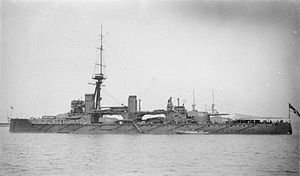Colossus-class battleship (1910)

Colossus at anchor, shortly after completion
|
|
| Class overview | |
|---|---|
| Name: | Colossus-class battleship |
| Operators: |
|
| Preceded by: | HMS Neptune |
| Succeeded by: | Orion class |
| Built: | 1909–1911 |
| In commission: | 1911–1921 |
| Completed: | 2 |
| Scrapped: | 2 |
| General characteristics (as built) | |
| Type: | Dreadnought battleship |
| Displacement: | 20,030 long tons (20,350 t) (normal) |
| Length: | 545 ft 9 in (166.3 m) (o/a) |
| Beam: | 85 feet 2 inches (26.0 m) or 86 feet 8 inches (26.4 m) |
| Draught: | 27 ft (8.2 m) |
| Installed power: |
|
| Propulsion: | 4 × shafts; 2 × steam turbine sets |
| Speed: | 21 knots (39 km/h; 24 mph) |
| Range: | 6,680 nmi (12,370 km; 7,690 mi) at 10 knots (19 km/h; 12 mph) |
| Complement: | 751–791 (1916) |
| Armament: |
|
| Armour: | |
The Colossus-class battleships were a pair of dreadnought battleships built for the Royal Navy (RN) at the end of the first decade of the 20th century, the last 12-inch-gunned (305 mm) battleships built for the RN. The sister ships spent their whole careers assigned to the Home and Grand Fleets, often serving as flagships. Aside from participating in the Battle of Jutland in May 1916, and the inconclusive Action of 19 August several months later, their service during the First World War generally consisted of routine patrols and training in the North Sea.
The Colossus class were deemed obsolete by the end of the war in 1918 and were reduced to reserve the following year. Hercules was sold for scrap in 1921, although Colossus was briefly used as a training ship. She was hulked in 1923 and sold for scrap five years later.
The initial 1909–1910 Naval Programme included two dreadnoughts and a battlecruiser, but was later increased to six dreadnoughts and two battlecruisers as a result of public pressure on the government due to the Anglo-German naval arms race. The original pair of battleships became the Colossus class and were improved versions of the preceding battleship, HMS Neptune. On 19 November 1908, Rear-Admiral Sir John Jellicoe, the Third Sea Lord and Controller of the Navy, proposed the changes that he would like to make to the Neptune's design. He wanted to redistribute the armor from locations not exposed to enemy fire to those that were and to fit 21-inch (533 mm) torpedoes in lieu of the 18-inch (450 mm) weapons used in the earlier ship; the number of spare torpedoes were to be increased as well. Likely prompted by an earlier memo from Admiral Francis Bridgeman, commander-in-chief of the Home Fleet, Jellicoe wanted to eliminate the mainmast and transfer most of the functions of its spotting top to an armoured spotting tower atop the conning tower in the superstructure. The Director of Naval Ordnance (DNO), Rear-Admiral Reginald Bacon, argued that the spotting top in the foremast should be retained. Jellicoe was willing to slightly increase the new design's displacement over Neptune, but it could not cost any more, which placed major constraints on the Director of Naval Construction (DNC), Sir Philip Watts.
...
Wikipedia
